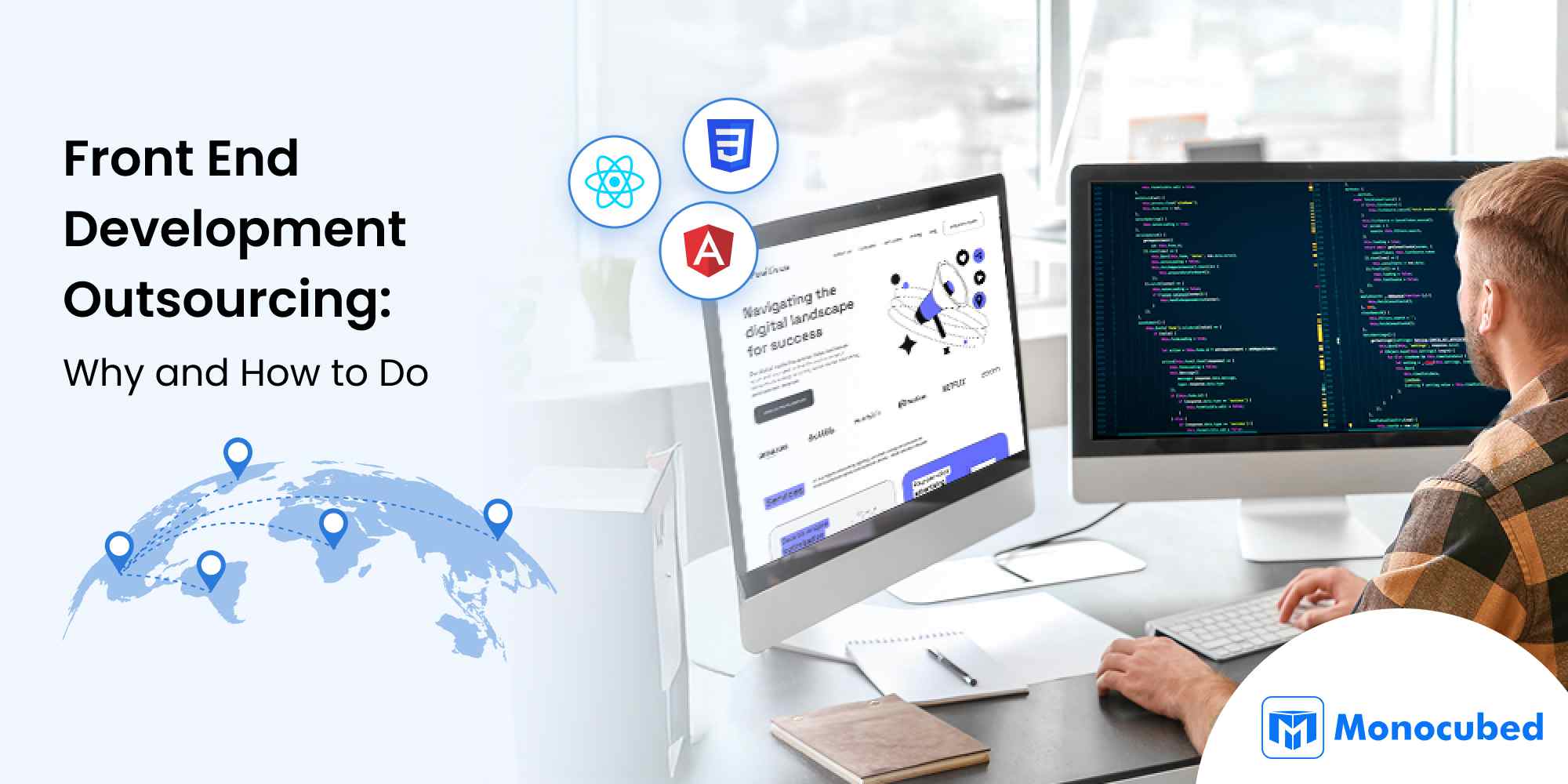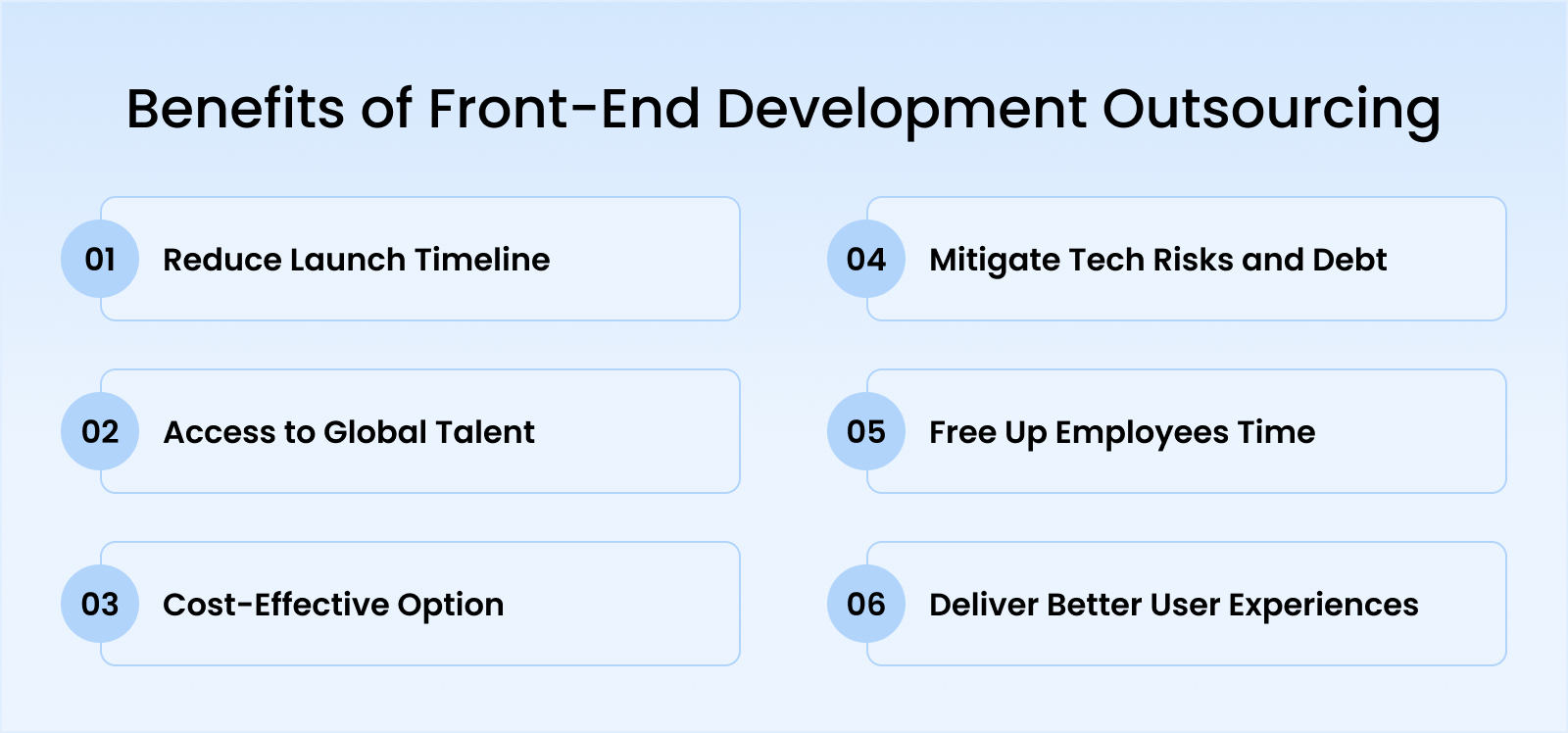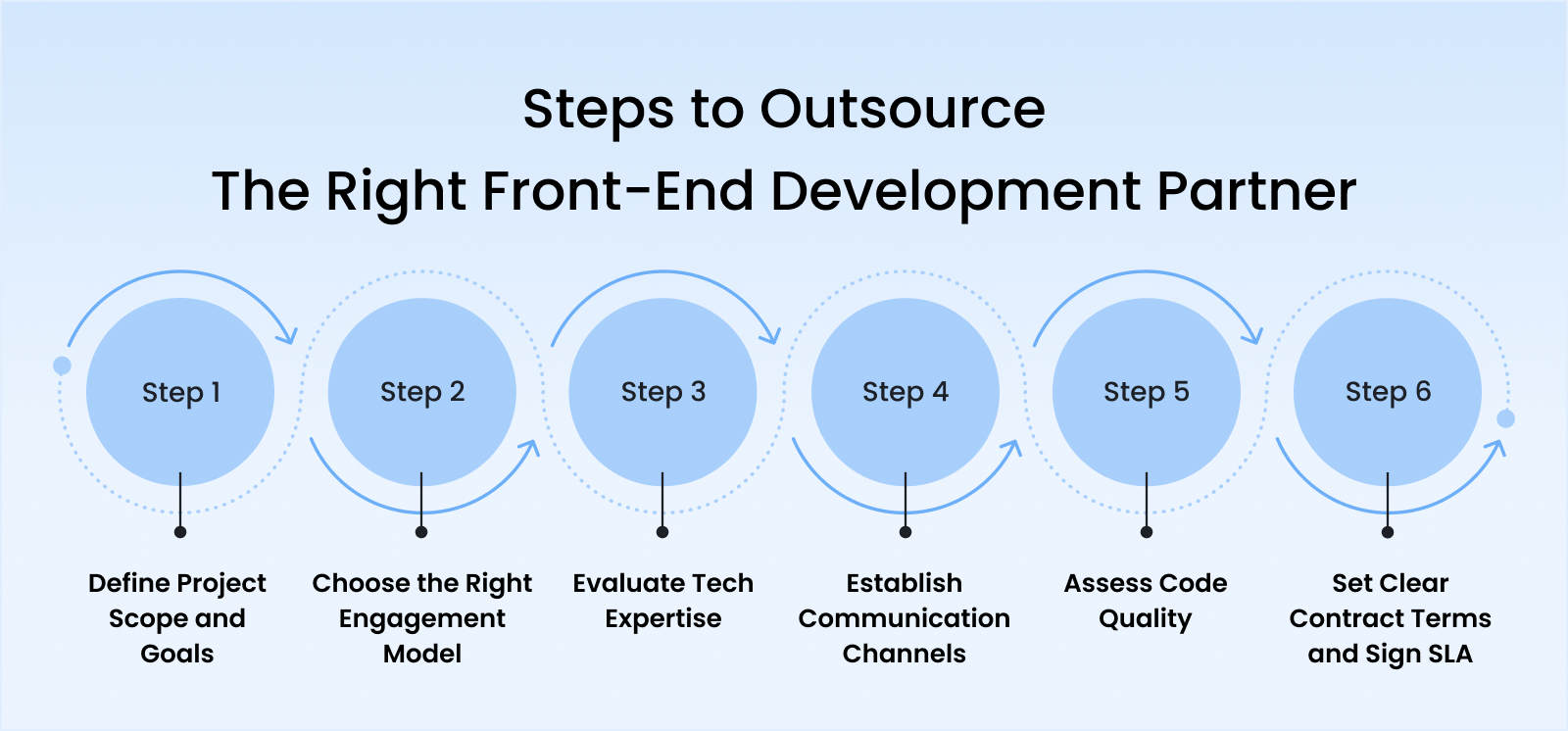Your competitors are launching faster, your users expect flawless experiences, and your internal team is either non-existent or drowning your business in technical debt.
Sound familiar?
If you’re a CTO watching development bottlenecks kill product momentum, or a founder burning cash on slow hiring cycles while opportunities slip away, you’re facing the modern dilemma.
“The solution is to outsource the right frontend development team faster.”
Outsourcing to a leading front end web development agency like Monocubed, which has a team of 20+ frontend developers to build and launch pixel-perfect, high-performing web applications.
By the end of this guide, you’ll have:
- A repeatable framework for selecting world-class frontend partners
- Cost models that predict the budget allocation for developing user interfaces
- A vendor checklist that helps you choose the right frontend web development partner
Whether you’re scaling your first product or optimizing enterprise applications, this guide provides the strategic depth and tactical precision you need to make frontend development outsourcing a competitive advantage.
Let’s begin.
Table of Contents
- 7 Key Benefits of Outsourcing Frontend Development Services for Your Business
- How to Outsource The Right Frontend Development Partner: 6 Simple Steps
- Frontend Development Cost Breakdown: Based on Project Complexity, Region, and Components
- 10 Red Flags That Signal a Bad Front-End Development Partner
- Why Outsource Frontend Development Services From Monocubed?
- Frequently Asked Questions
7 Key Benefits of Outsourcing Frontend Development Services for Your Business
The most successful companies don’t outsource to save money—they outsource to gain unfair advantages. Here’s how strategic frontend partnerships deliver exponential returns:
-
Compress development timelines by 40-60%
Internal hiring cycles take 4-6 months. Training may take another 2-3 months. Your competitive window might be 6 months total. This creates a big problem when you want to deploy the projects within a few weeks.
Outsourcing to a frontend web development company enables you to deploy experienced teams within 1-2 weeks. They are skilled in your project’s tech stack, industry best practices, and have refined workflows through similar projects. It reduces your recruitment timeline and allocates time to developing and deploying successful projects with highly responsive frontends.
At Monocubed, we’ve helped clients like FieldCamp, field service management platform, launch their React-based service management platform with 750K+ active users by leveraging our proven development processes.
-
Access global talent pools (not just local limitations)
Outsourced frontend development options provide access to worldwide tech talent specializing in modern frontend frameworks and technologies, such as React, Angular, or Vue.js.
They also have deep expertise in your industries (fintech, healthcare, e-commerce) and experience in implementing industry compliance to build a secure frontend for the applications.
Choosing to hire frontend developers allows you to give access to new tools, frameworks, and methodologies. This gives you the ability to set a competitive advantage for your business and easily meet critical deadlines.
-
More cost-effective than building a frontend team
Hiring a senior frontend developer typically costs over $110,000 annually when you consider salary, benefits, equipment, and overhead. In contrast, outsourcing allows you to pay between $1,000 and $20,000, depending on the project complexity, timeline, and tech stack.
This shows hiring an expert frontend development team for any type of projects, including MVP, enterprise-grade apps, or a web portal, reduces your development cost.
It also offers other financial benefits:
- Eliminate 6-12 months of recruitment costs
- No long-term employment commitments
- Scale spend directly with business growth
- Redeploy savings toward marketing, sales, or additional features
-
Expertise in mitigating technical and delivery risks
Outsource frontend developers brings strong quality assurance through comprehensive testing, thorough code reviews, and continuous performance monitoring right from the start.
They follow mature, proven workflows, agile project management, and clear communication protocols that can lower project failure rates. Their deep expertise in handling similar projects multiple times helps avoid common architectural pitfalls and technical errors.
Additionally, frontend development agencies like Monocubed offer clear contracts, service level agreements (SLAs), and milestone tracking to ensure accountability, legal protection, and ongoing support.
-
Focus internal resources on core business operations
When you hire front-end developers, your internal team concentrates on strategic priorities like product strategy, business logic, and market differentiation.
This avoids costly training on specific frameworks, allowing your internal talent to deepen domain expertise.
Moreover, partnering with self-managing, seasoned web development teams reduces your managerial burden, streamlining the development process and successful project deployment.
-
Deliver user experiences that improve customer engagement
Outsourced frontend engineers expertly optimize key metrics like Core Web Vitals, fast load times, and smooth interactions to create a seamless user experience that drives engagement.
They ensure consistent performance across all browsers and devices through thorough testing and implement WCAG accessibility standards, expanding your market while minimizing legal risks. Our team built InvoiceOwl (project estimation software) that has an intuitive interface using PHP and Laravel, resulting in over 27,000 invoices generated and over 15,000 downloads.
Additionally, the test every element of the interfaces to maximize the engagement, lead generation, conversions, helping your product captivate users, and deliver a substantial business impact.
How to Outsource The Right Frontend Development Partner: 6 Simple Steps
A team of skilled frontend developers with specialized technical expertise, valuable insights, and innovative solutions can turn your vision into a fast-loading, conversion-optimized web application. It’s essential to select the right partner that meets your deadlines and reduces development costs by 40-60%.
Here is the step-by-step guide for choosing a reliable frontend development service provider:
Step 1: Define your project scope and business goals
Start by clearly outlining:
- The type of frontend development services you need (e.g., React web app, e-commerce platform, PWA, mobile-responsive site)
- Core functionalities and expected user experience outcomes
- Performance requirements (Core Web Vitals, load times, accessibility standards)
- Timeline and budget range
After defining what exactly you want, create a simple PRD (Product Requirements Document) or project brief to avoid misunderstandings later. Use tools like Notion, Figma, or Google Docs for outlining project scope and sharing with your vendor.
Step 2: Choose the right engagement model
The next step is to pick the right engagement model or outsourcing approach based on your budget and project needs:
| Engagement Model | Description | Estimated Cost (USD/month) |
|---|---|---|
| Staff Augmentation Model | This model involves temporarily expanding your in-house team with external frontend developers. | $3,000 – $8,000 per developer |
| Dedicated Team Model | In this model, you will get a dedicated frontend team that focuses on your project for an extended period. | $8,000 – $25,000+ depending on team size |
| Full Project Outsourcing Model | Here, you can delegate your entire frontend project to a development agency or external team. They will handle the development process, from conception to delivery. | $20,000 – $150,000+ per project |
Step 3: Evaluate technical knowledge and framework expertise
Before hiring a frontend development agency, conduct a thorough evaluation of their technical depth, project experience, and framework alignment.
- Framework proficiency: Ensure the team is skilled in relevant frameworks, such as React, Angular, Vue.js, or Next.js, and uses modern web development tools.
- Industry-specific experience: Review their portfolio or case studies in areas like e-commerce development, SaaS platforms, healthcare applications, or fintech solutions with performance optimization and accessibility compliance.
- Project relevance: Ask for examples of similar project scopes, such as progressive web apps, conversion-optimized e-commerce sites, or complex dashboard interfaces.
- Code quality and architecture: Request access to public GitHub repositories or conduct a technical code review to assess code quality, testing practices, and architecture decisions.
Check their technical expertise and experience on third-party platforms, such as Clutch.co, GitHub, LinkedIn, and portfolio websites. Look for development teams that have launched apps with measurable performance improvements and positive client testimonials.
Step 4: Discuss and establish strong communication channels
Establish communication expectations before the project begins, especially when working across time zones or with distributed teams.
- Discuss preferred platforms such as Slack for instant messaging, Zoom or Google Meet for video calls, and Jira, Trello, or ClickUp for task tracking and sprint management.
- Define how often updates will be shared (daily stand-ups, weekly reviews, or milestone reports), and set expectations for response times, meeting availability, and time zone overlap.
- If your outsourcing frontend development company operates in a different region, try to overlap at least 3–4 working hours for live syncs and real-time collaboration.
You can adopt tools like Loom for screen-recorded updates or Notion for centralized documentation and feedback to support the rapid development process. Professional frontend developers from top web development companies actively use these collaboration tools to keep clients aligned and ensure complete project transparency.
Step 5: Emphasize code quality and performance standards
When outsourcing frontend development, maintaining high code quality and strong performance standards is non-negotiable. Ensure your development partner adheres to clean coding practices and follows best practices for Core Web Vitals optimization, accessibility compliance, and cross-browser compatibility.
Ask whether they conduct regular code reviews, implement automated testing (unit tests, integration tests, end-to-end testing), and follow CI/CD pipelines to catch bugs early and deploy confidently. Ensure their expertise in implementing performance-first architectures and familiarity with SEO best practices and modern optimization techniques.
When frontend outsourcing teams focus on providing high-quality, scalable codebases, it helps you avoid extra development expenses after project launch and saves your resources.
Step 6: Set clear SLAs and contract terms
A well-structured outsourcing contract should include clearly defined Service Level Agreements (SLAs) that outline expectations, deliverables, and accountability. These agreements protect both parties and ensure transparency throughout the engagement.
The agreement must include:
- Delivery timelines: Specify milestone dates, design approval phases, development sprints, and final handover deadlines.
- Performance metrics and benchmarks: Define standards for key metrics, including Core Web Vitals scores, page load times, mobile responsiveness, and accessibility compliance.
- Escalation procedures: Establish clear steps for resolving issues, handling scope changes, and enforcing quality standards for non-compliance.
- Post-delivery support: Include terms for ongoing maintenance, performance monitoring, bug fixes, and technical support once the project goes live.
Choosing the right frontend development partner is crucial to delivering a fast, scalable, and user-friendly product while optimizing costs and minimizing risks. By following these six steps, you can ensure a successful outsourcing experience that accelerates your project timeline and maximizes business value.
Skip the Hiring Process, Work With a Pre-Vetted Frontend Development Team
Our trained and experienced frontend web developers help you turn your vision into compelling, highly responsive user interfaces that attract and engage more customers.
Frontend Development Cost Breakdown: Based on Project Complexity, Region, and Components
Frontend development costs vary widely depending on the complexity of the project and the geographic location of the development team. Below are typical cost ranges and factors influencing pricing.
Here is the clear breakdown of the cost of three factors:
-
Cost by project complexity
Project Type Typical Features Estimated Cost Range (USD) Development Timeframe Basic / MVP Login, forms, basic content $3,000 – $15,000 1 – 3 months Mid-Level Application Dashboards, APIs, CMS, payment gateway $15,000 – $60,000 3 – 6 months Enterprise Application AI integration, real-time updates, multi-role access $60,000 – $150,000+ 6 – 12+ months Note: Costs include coding, responsive design, UI implementation, and testing for the frontend.
-
Cost by region
Region Hourly Rate (USD) Approximate Monthly Cost per Developer (USD) United States / Canada $100 – $200 $16,000 – $32,000 Western Europe / UK $80 – $150 $12,800 – $24,000 Eastern Europe $40 – $80 $6,400 – $12,800 India / Southeast Asia $20 – $50 $3,200 – $8,000 Note: Rates vary based on developer seniority and outsourcing vendor type. Outsourcing to regions like India or Eastern Europe significantly reduces costs compared to the US or Western Europe.
-
Typical frontend development cost components
Development Phase Estimated Cost Range (USD) Description UI/UX Design $2,000 – $10,000 Wireframes, user interface design Frontend Development $3,000 – $20,000 Coding UI, integrating frontend frameworks Quality Assurance (QA) $1,000 – $5,000 Testing and performance optimization Maintenance (annual) $5,000 – $30,000 Bug fixes, updates, performance monitoring Note: UI/UX design and QA significantly impact the frontend cost but are essential for a polished user experience.
This cost breakdown provides a practical view to help businesses budget their frontend development by matching project goals with appropriate technical investment and regional pricing advantages. For more detailed information, check our comprehensive guide on web app development cost.
10 Red Flags That Signal a Bad Front-End Development Partner
These warning signs have cost companies millions in failed projects. Learn to spot them during evaluation to avoid costly mistakes.
-
No live project demonstrations
What it looks like:
- Portfolio contains only screenshots or static mockups
- Refuses to provide live URLs for testing
- Can’t demonstrate interactive features during presentations
Why it matters: Screenshots can be stolen from other projects. Live sites prove actual development capabilities.
What to do: Insist on testing live applications. Ask specific questions about implementation details.
-
Inability to explain technical decisions
What it looks like:
- Generic responses to framework choice questions
- Can’t explain why they chose React over Angular for specific projects
- No discussion of performance optimization strategies
Example: You asked: “Why did you choose Vue.js for this e-commerce project?” If they replied: “Vue.js is good for e-commerce projects.”
When you outsource an expert web development team, they say:
“We chose Vue.js because the client needed rapid development, the team was experienced with Vue’s composition API, and the project required excellent SEO.
-
No discovery phase or requirements analysis
What it looks like:
- Provides estimates without detailed discussions
- Doesn’t ask about target audience, business goals, or success metrics
- No questions about existing systems, integrations, or constraints
What to do: Check whether they’ve conducted thorough 2-4 hour discovery and project analysis sessions, ask detailed questions about business objectives, and strategic recommendations.
-
Unclear project management methodology
What it looks like:
- Can’t explain their development process
- No mention of sprint planning, daily standups, or retrospectives
- Unclear deliverable milestones and acceptance criteria
Warning signs:
- “We just build what you ask for.”
- No project management tools or transparency
- Ad-hoc communication without structure
What to do: Ask them about their proven frontend development process that helps you keep your team aligned at every stage of development and stay updated on what’s happening at each phase.
-
No quality assurance process
What it looks like:
- No testing methodology discussion
- Can’t explain code review processes
- No mention of performance testing or accessibility compliance
- “We test as we build,” without formal QA procedures
What to do: Ensure they focus on automated testing methods, conduct regular code reviews, meet performance benchmarks, and perform daily or weekly accessibility audits.
-
Poor communication during the sales process
What it looks like:
- Delayed responses to questions (>48 hours)
- Unclear explanations of technical concepts
- Difficulty scheduling meetings or demos
- Language barriers affecting technical discussions
What to do: Observe the team’s communication skills and quality during the project meeting, and ask about the communication and collaboration channels.
-
No client references or testimonials
What it looks like:
- Refuses to provide client contacts for reference calls
- Only generic testimonials without client names or details
- Can’t offer case studies with measurable results
Professional standard: 3-5 recent client references, detailed case studies, verified testimonials on third-party platforms
-
Vague contract terms and scope definition
What it looks like:
- Generic contracts without project-specific details
- Undefined deliverables or acceptance criteria
- No clear intellectual property rights assignment
- Vague timeline and milestone definitions
Contract essentials:
- Specific deliverables with acceptance criteria
- Clear IP ownership assignment
- Detailed payment schedule tied to milestones
- Performance guarantees and remediation procedures
-
No post-launch support planning
What it looks like:
- Views project completion as the final relationship end
- No maintenance or support service offerings
- Can’t explain bug fix procedures or warranty terms
- No knowledge transfer or documentation plans
What to do: Ask whether they offer 30-90 day warranty periods, ongoing support options, and comprehensive documentation delivery
-
Lack of security and compliance understanding
What it looks like:
- No discussion of data protection or privacy requirements
- Unfamiliar with industry compliance standards (GDPR, HIPAA, SOC 2)
- Can’t explain secure development practices
- No security audit or penetration testing capabilities
What to do: If you are looking for a frontend development solution for Healthcare, financial services, e-commerce, or any application handling sensitive data, you must confirm what industry compliance the company or team adheres to.
Before signing the contract with your frontend development service provider, make sure they meet all the qualities in the following checklist:
✅ Live project testing and technical interviews completed
✅ Client references contacted and verified
✅ Code samples reviewed by technical team member
✅ Contract terms reviewed by legal counsel
✅ Security and compliance requirements addressed
✅ Communication protocols tested and agreed upon
✅ Project scope and deliverables clearly defined
✅ Payment schedule tied to specific milestones
✅ Post-launch support terms negotiatedPro Tip: Trust your instincts. If something feels wrong during evaluation, it usually gets worse during development.
Why Outsource Frontend Development Services From Monocubed?
Outsourcing frontend web app development is a strategic choice when you want faster project delivery, reduced costs, and access to top-tier frontend talent without expanding your internal team.
At Monocubed, we bring years of hands-on experience, transparency in development, and deep technical expertise to build scalable, high-performance frontend applications customized to your needs.
Our proven track record includes:
- InterStride: Built a career platform using Ruby on Rails that now serves 80K+ active users across 130+ university partners.
- Sayyar: Developed an advanced eCommerce platform processing 2,80,000+ orders from 2,00,000+ customers.
- MRS (Roofing CRM Software): Created an all-in-one roofing contractor management solution serving 100+ roofing contractors with 99.98% data security.
When you partner with our web development team, you gain immediate access to:
- Domain-aligned frontend engineers skilled in the latest frameworks like React, Angular, and Vue.js
- 100% data security and regular updates, ensuring privacy and compliance
- Secure DevOps workflows, clean and maintainable code, with full intellectual property ownership
- A proactive, agile, and sprint-driven development process for faster time-to-market
Let’s connect to explore how Monocubed’s frontend development experts can help you deliver engaging, high-quality digital experiences tailored precisely to your requirements.
Outsource Frontend Development Without Sacrificing Performance
Partner with Monocubed to build secure, scalable, and lightning-fast user interfaces that align with your business goals, domain compliance, and meet user expectations.
Frequently Asked Questions
-
What is frontend development outsourcing?
Frontend development outsourcing means hiring an external team or agency to handle the user interface (UI) and user experience (UX) design and coding of your website or application, rather than doing it in-house.
-
What does a frontend developer do?
A front-end developer creates the visual, interactive parts of websites using HTML, CSS, and JavaScript, ensuring responsiveness, performance, accessibility, and cross-browser compatibility to deliver seamless user experiences.
-
What should be included in a good outsourcing contract?
A strong contract covers delivery timelines, quality benchmarks, escalation procedures, intellectual property rights transfer, and post-delivery support to safeguard project success.
-
How can I manage communication and time zone differences?
Set up regular meetings, utilize collaboration tools such as Slack, Zoom, and Jira, and ensure at least 3-4 hours of time zone overlap for live syncing. Clear documentation and proactive updates are critical for success
-
What’s the difference between hiring freelancers vs an agency?
Freelancers are cost-effective for small projects but lack scalability. Agencies like Monocubed provide complete teams, project management, quality assurance, and ongoing support for complex projects.
-
How do you ensure code quality when outsourcing?
Look for partners who follow code review processes, automated testing, CI/CD pipelines, and provide performance benchmarks. Request code samples and live project demonstrations before hiring.
-
Can you work with our existing team and codebase?
Yes, experienced frontend development partners can integrate with your existing team, follow your coding standards, and enhance your current codebase while maintaining consistency.
-
What technologies should I choose for my frontend project?
You can choose the popular frontend technologies, including:
- React for flexibility
- Angular for enterprise applications, and
- Vue.js for rapid development.
Your choice depends on project requirements, feature choice, and long-term maintenance needs.
 By Yuvrajsinh Vaghela
By Yuvrajsinh Vaghela




